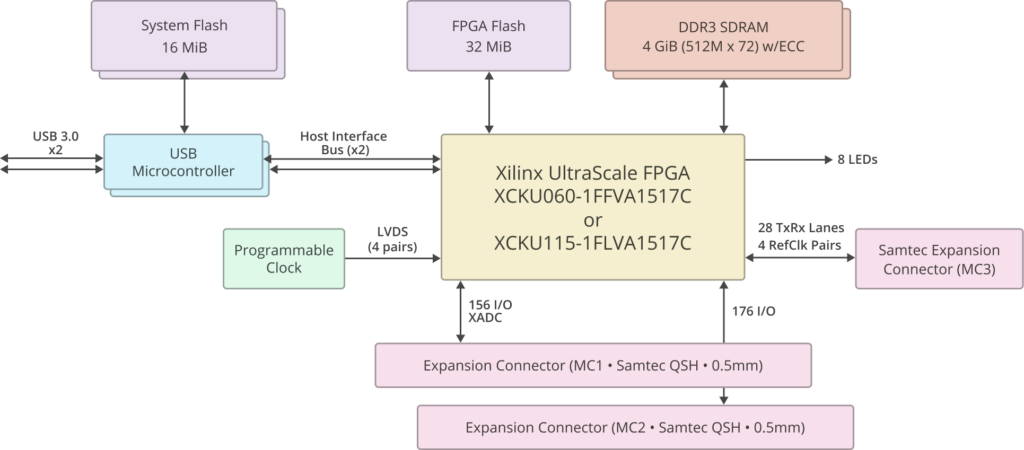Introduction

The XEM8350 is a compact, mezzanine-style FPGA integration module featuring the Xilinx Kintex UltraScale FPGA and SuperSpeed USB 3.0 connectivity via two USB 3.0 receptacles.
Designed as an FPGA development board and full-featured integration system, the XEM8350 provides access to over 330 I/O pins on its 1517-pin Kintex UltraScale device and has 4-GiByte DDR4 SDRAM available to the FPGA. Three SPI Flash devices provide a total of 64 MiB of non-volatile memory, two attached to the USB microcontrollers and one attached to the FPGA.
Available with KU060 density, the XEM8350 is designed for high-performance system integrations including transceiver-capable peripherals such as JESD204B data converters.
Documentation and Reference Materials
The following is a comprehensive list of documentation available for this device.
| XEM8350 User’s Manual | This online documentation space. |
| XEM8350 Pins Reference | The interactive Pins reference for the device provides detailed pinout information as well as automated constraint file generation. Export functionality is provided to PDF, CSV. Constraint files are provided for UCF, XCD (Xilinx) and QSF, SDF (Altera). |
| FrontPanel SDK User’s Manual | The online documentation space for the FrontPanel SDK. |
| FrontPanel API Reference | Online API reference with detailed usage for every API method. |
Functional Block Diagram

FPGA
The XEM8350 is offered in one variant. The table below lists some of the features of the device. Please consult the Xilinx documentation for a more thorough overview.
| FEATURE | XEM8350-KU060T |
|---|---|
| FPGA | XCKU060-1 |
| System Logic Cells | 725,550 |
| D Flip-Flops | 663,360 |
| Distributed RAM | 9.1 Mib |
| Block RAM | 38.0 Mib |
| DSP Slices | 2,760 |
| Clock Management Tiles | 12 |
SuperSpeed USB 3.0 Interface
The XEM8350 uses a pair of Cypress FX3 USB microcontrollers to make the XEM a USB 3.0 peripheral. As a USB peripheral, the XEM is instantly recognized as a plug and play peripheral on millions of PCs. More importantly, FPGA downloads to the XEM happen quickly, virtual instruments under FrontPanel update quickly, and data transfers are blazingly fast.
The two USB 3.0 interfaces are completely independent and communicate with the FPGA logic using two separate host interfaces. This allows for full duplex communication with host software.
On-board Peripherals
The XEM8350 is designed to compactly support a large number of applications with a small number of on-board peripherals. These peripherals are listed below.
Clock Generator
An Si5338B configurable clock generator provides four user configurable clock signals to the FPGA. Two of these signals are accessible to the FPGA fabric through global clock inputs. The remaining two clock signals are provided as GTH transceiver quad reference clock inputs.
4-GiByte 72-bit-wide DDR4 Synchronous DRAM
The module also includes 4-GiByte DDR4 SDRAM with a full 72-bit ECC-capable interface to the FPGA. This SDRAM is attached exclusively to the FPGA and does not share any pins with the expansion connector. The maximum clock rate of the SDRAM is 1200 MHz. With the -1 speed grade of the Kintex Ultrascale, the maximum clock rate is 1066 MHz for a supported peak memory bandwidth of 136 Gib/s.
The DDR4 SDRAM is a Micron MT40A512M16LY-075:E (or compatible).
FPGA Flash – 32 MiB Serial Flash Memory
A 256 Mib serial flash device (ISSI IS25WP256D or equivalent) provides on-board non-volatile storage for the FPGA. This device is attached directly to the FPGA through the FPGA configuration interface for use in your design.
System Flash – 2x 16 MiB Serial Flash Memory
A 128 Mib serial flash device (Numonyx N25Q128A11B1240E or equivalent) provides on-board non-volatile storage accessible to each of the USB microcontrollers. This device is used to store device firmware and configuration settings as well as other user assets such as calibration data. Erase, read, and write functions are available at all times (with or without a configured FPGA) through the use of FrontPanel API methods.
LEDs
Eight LEDs are available for general use as indicators.
FPGA Fan Controller
A small connector provides power to an optional fan mounted on the FPGA heat sink. This power is under the control of the primary USB microcontroller. The 5-16-volt DC input voltage to the board is applied to the fan when active.
Device Sensors
On-board voltage and current sensors provide real-time access to several power supply measurements through the FrontPanel SDK sensors API.
FrontPanel Support
The XEM8350 is fully supported by Opal Kelly’s FrontPanel Application. FrontPanel augments the limited peripheral support with a host of PC-based virtual instruments such as LEDs, hex displays, pushbuttons, toggle buttons, and so on. Essentially, this makes your PC a reconfigurable I/O board and adds tremendous value to the XEM8350 as an experimentation or prototyping system.
Programmer’s Interface
In addition to complete support within FrontPanel, the XEM8350 is also fully supported by the FrontPanel SDK, a powerful C++ class library available to Windows, Mac OS X, and Linux programmers allowing you to easily interface your own software to the XEM.
In addition to the C++ library, wrappers have been written for C#, Java, and Python making the API available under those languages as well. Sample wrappers (unsupported) are also provided for Matlab and LabVIEW.
Complete documentation and several sample programs are installed with FrontPanel.
Copyright
Software, documentation, samples, and related materials are Copyright © 2006-2021 Opal Kelly Incorporated.
Opal Kelly Incorporated
Portland, OR
https://www.opalkelly.com
All rights reserved. Unauthorized duplication, in whole or part, of this document by any means except for brief excerpts in published reviews is prohibited without the express written permission of Opal Kelly Incorporated.
Opal Kelly® and FrontPanel® are registered trademarks of Opal Kelly Incorporated. Linux is a registered trademark of Linus Torvalds. Microsoft and Windows are both registered trademarks of Microsoft Corporation. All other trademarks referenced herein are the property of their respective owners and no trademark rights are claimed.